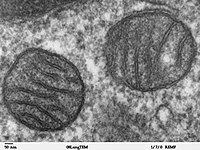
Photo from wikipedia
Background Fat stranding is a non-specific finding of an increased fat attenuation on computed tomography (CT) images. Fat stranding is used for detecting the underlying lesion in humans. Objectives To… Click to show full abstract
Background Fat stranding is a non-specific finding of an increased fat attenuation on computed tomography (CT) images. Fat stranding is used for detecting the underlying lesion in humans. Objectives To assess the clinical significance of fat stranding on CT images for identifying the underlying cause in dogs and cats. Methods In this retrospective study, the incidence, location, extent, distribution, and pattern of fat stranding were assessed on CT studies obtained from 134 cases. Results Fat stranding was found in 38% (51/134) of all cases and in 35% (37/107) of tumors, which was significantly higher in malignant tumors (44%) than benign tumors (12%). Moreover, fat stranding was found in more than two areas in malignant tumors (16/33) and in a single area in benign tumors (4/4). In inflammation, fat stranding was demonstrated in 54% (7/13) in a single area (7/7) as a focal distribution (6/7). In trauma, fat stranding was revealed in 50% (7/14) and most were in multiple areas (6/7). Regardless of the etiologies, fat stranding was always around the underlying lesion and a reticular pattern was the most common presentation. Logistic regression analysis revealed that multiple areas (p = 0.040) of fat stranding and a reticulonodular pattern (p = 0.022) are the significant predictors of malignant tumor. Conclusions These findings indicated that CT fat stranding can be used as a clue for identifying the underlying lesion and can be useful for narrowing the differential list based on the extent and pattern.
Journal Title: Journal of Veterinary Science
Year Published: 2022
Link to full text (if available)
Share on Social Media: Sign Up to like & get
recommendations!